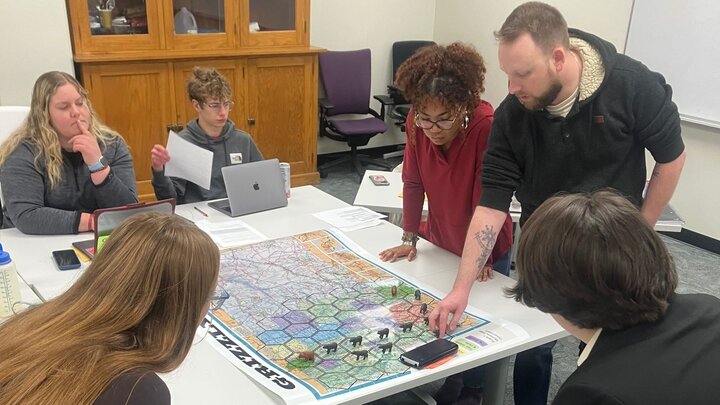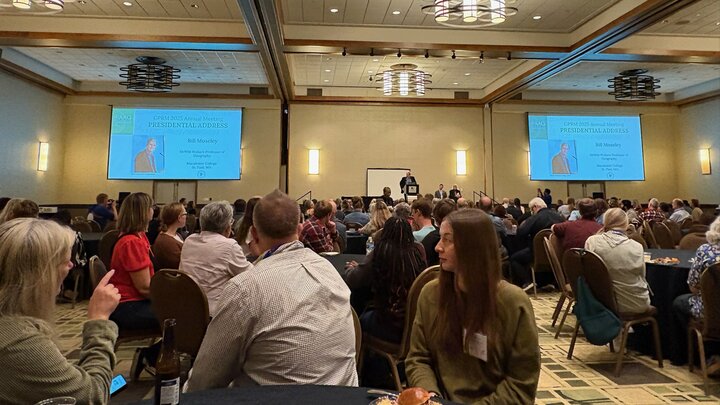In September, James Benes, a lecturer in the School of Global Integrative Studies (SGIS), took his students to explore a Nebraska farm that contains Conservation Reserve Program (CRP) lands. The outing, part of his Global Environmental Issues class, offered a hands-on experiential learning opportunity, with one student sharing that they had never been on a farm before.
“'GEOG 181: Global Environmental Issues' is an introductory course about the challenges facing our shared spaces as a society,” Benes said. “We learn about these issues through the spatial lens and discuss biodiversity, environmental variability, agricultural stressors, pollution, water systems, and more.”
Benes joined SGIS as a lecturer in Fall 2025 and loves being outdoors, the earth sciences, and connecting with students. He teaches courses on physical geography, world regional geography, biogeography, and military geography. He has also served in the U.S. Coast Guard and is currently in the U.S. Navy Reserves.
His research focuses on environmental change, paleoecology, and fire history, but he actively pursues a wide range of interdisciplinary research topics. One of his academic passions is mentorship, primarily through programs at the University of Nebraska–Lincoln (UNL), such as Undergraduate Creative Activities and Research Experience (UCARE). Benes is a First-Generation student and a proud Nebraskan with rural roots. Having grown up on a farm himself, he sees the wisdom in helping students engage in active learning through the world around them.

“I notice that students tend to remember the things they see and touch better than the things they learn about in a lecture. I like to offer them that tactile learning experience,” Benes said. He shared several engaging examples.
“In this class, we were learning about greenways and bioswales in urban settings, so I decided to simply take them out into the downtown Lincoln areas to see the bioswales and permeable pavement. In my other classes, I have created ‘rock tours’, ‘tree tours’, and organized field trips to Robber’s Cave,” Benes said. “Campus is so beautiful, it’s easy to take advantage of it when learning about geography and landscape dynamics.”
The focus of this field trip was the Conservation Reserve Program (CRP). The Farm Service Agency, with the U.S. Department of Agriculture, states that the CRP “is a voluntary program that encourages agricultural producers and landowners to convert highly erodible and other environmentally sensitive acreage to vegetative cover, such as native grasses, trees, and riparian buffers.”
To learn more, the students visited a farm that belongs to Benes’s uncle, Mark Benes. Before the weekend field trip, Benes invited his uncle to give a lecture in the classroom.

“The Nebraska farm I grew up on was right next to this one, and I spent a lot of time there as a young boy and teenager. I enjoyed going to Uncle Mark’s to work and explore,” Benes said. “My uncle has two conservation easements where the government pays him not to develop lands that have a high potential for erosion.”
While at the farm, students examined the types of land management practices landowners like Uncle Mark can utilize to be part of the CRP. These practices include tree removal, prescribed burnings, and the establishment of resource-conserving cover grasses that inhibit soil erosion, improve the quality of water, and increase the presence of wildlife.
The students enjoyed taking a hay-rack ride, learning about topography and drainage, and identifying native plant species in the tallgrass prairie.
“I hope that students were able to see the benefits of CRP land in practice. But, most of all, I wanted to offer students an experiential learning opportunity that allowed them to connect to a tallgrass prairie, an oak woodland, and all the different landscapes in between,” Benes said. “I wanted to offer a moment to breathe in the smells of late summer, hearing the crunch of soil and grass, run their hands over a goldenrod in full bloom, and to collect acorns. These are all things that create what geographers call a ‘sense of place.’”



